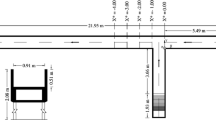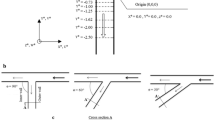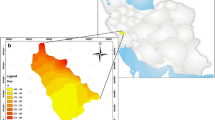Abstract
Laboratory experiments were used to estimate the hydraulic performance of emitters, i.e., the emitter flow variation (qvar) and manufacturer’s coefficient of variation (CVm), by measuring the discharge of different labyrinth-channel emitters at different operating pressures (P) and water temperatures (T). Considering the importance of the structural parameters of the labyrinth-channel emitters in drip irrigation design, which has been experimentally confirmed, artificial neural network (ANN) and gene expression programming (GEP) models were developed to predict qvar and CVm. The ANN and GEP models were trained and tested using structural parameters (including the number, height (H), and spacing of trapezoidal units and the flow path width and length) of different labyrinth-channel emitters, P and T as the input variables, and qvar and CVm as the outputs. Statistical criteria, including the coefficients of correlation (r), relative root-mean-square error (RRMSE), and mean absolute error (MAE), were used to examine the accuracy of the developed models. The ANN models exhibited good correlation with experimental values, with high r values 0.995 and 0.969 for qvar and 0.997 and 0.947 for CVm in the training and testing processes, respectively. The ANN models had lower RRMSE and MAE values than the GEP models. Furthermore, H was the dominant variable for obtaining the most accurate prediction model. The results confirm that the ANN models are superior to the GEP models for the prediction of the hydraulic performance of emitters.








Similar content being viewed by others
Abbreviations
- ANN:
-
Artificial neural network
- \(\left( {B_{ 1} } \right)_{j}\) :
-
Biases in the hidden layer
- \(\left( {B_{ 2} } \right)_{k}\) :
-
Biases in the output layer
- C sx :
-
Skewness coefficient
- \({\text{CV}}_{\text{m}}\) :
-
Manufacturer’s coefficient of variation
- f :
-
Activation function
- GEP:
-
Gene expression programming
- H:
-
Trapezoidal unit height (mm)
- k x :
-
Kurtosis coefficient
- L :
-
Path length (mm)
- m :
-
Number of data
- MAE:
-
Mean absolute error
- N :
-
Trapezoidal unit number
- \(n_{i}\) :
-
Number of input neurons
- \(n_{j}\) :
-
Number of hidden neurons
- \(n^{\prime}\) :
-
Total number of emitters along the drip line
- P :
-
Operating pressure (kPa)
- \(q_{i}\) :
-
Discharge rate of emitter i (L h−1)
- \(q_{\max}\) :
-
Maximum emitter discharge rate (L h−1)
- \(q_{\min}\) :
-
Minimum emitter discharge rate (L h−1)
- \(q_{\text{var}}\) :
-
Emitter flow variation (%)
- \(\bar{q}\) :
-
Average emitter discharge rate (L h−1)
- r :
-
Coefficient of correlation
- RMSE:
-
Root-mean-square error
- RRMSE:
-
Relative root-mean-square error
- S:
-
Trapezoidal unit spacing (mm)
- \(S_{x}\) :
-
Standard deviation
- T :
-
Water temperature (°C)
- W :
-
Path width (mm)
- \(\left( {W_{ 1} } \right)_{ji}\) :
-
Weights from the input layer to the hidden layer
- \(\left( {W_{2} } \right)_{kj}\) :
-
Weights from the hidden layer to the output layer
- x :
-
Value of either the hidden-layer neuron or the output-layer neuron
- \(X_{Ei}\) :
-
Experimental value
- \(X_{i}\) :
-
Normalized inputs
- \(x_{\max}\) :
-
Maximum value
- \(x_{\text{mean}}\) :
-
Mean value
- \(x_{\min}\) :
-
Minimum value
- \(X_{Pi}\) :
-
Predicted value
- \(\overline{{X_{\text{E}} }}\) :
-
Average value of the experimental data
- \(Y_{k}\) :
-
Outputs
- i :
-
Number of input neuron
- j :
-
Number of hidden neuron
- k :
-
Number of output neuron
References
Alamoud AI, Mattar MA, Ateia M (2014) Impact of water temperature and structural parameters on the hydraulic labyrinth-channel emitter performance. Span J Agric Res 12(2):580–593
Alazba AA, Yassin MA, Mattar MA (2016) Modeling daily evapotranspiration in hyper-arid environment using gene expression programming. Arab J Geosci 9(3):202
Al-Ghobari HM, El-Marazky MS, Dewidar AZ, Mattar MA (2018) Prediction of wind drift and evaporation losses from sprinkler irrigation using neural network and multiple regression techniques. Agric Water Manage 195:211–221
ASABE (2005) EP-458: field evaluation of microirrigation systems. ASABE, St. Joseph, USA
ASCE Task committee (2000) Artificial neural networks in hydrology I: preliminary concepts. J Hydrol Eng ASCE 5(2):115–123
Ayars JE, Phene CJ, Hutmacher RB, Davis KR, Schoneman RA, Vail SS, Mead RM (1999) Subsurface drip irrigation of row crops: a review of 15 years of research at the water management research laboratory. Agric Water Manage 42:1–27
Bralts VF, Wu IP, Gitlin HM (1981) Manufacturing variation and drip irrigation uniformity. Trans ASABE 24(1):113–119
Clark GA, Lamm FR, Rogers DH (2005) Sensitivity of thin-walled drip tape emitter discharge to water temperature. Appl Eng Agric 21(5):855–863
Cook FJ, Thorburn PJ, Fitch P, Bristow KL (2003) Wet up: a software tool to display approximate wetting patterns from drippers. Irrig Sci 22(3–4):129–134
Decroix M, Malaval A (1985) Laboratory evaluation of trickle irrigation equipment for field. In: Proc 3rd Int Drip/Trickle Irrig Cong, California, USA, vol 1, pp 325–338
Dogan E, Kirnak H (2010) Water temperature and system pressure effect on drip lateral properties. Irrig Sci 28:407–419
Enciso J, Portar D (2005) Basics of microirrigation. Publications of Texas Cooperative Extension, Texas A&M University, Weslaco and Lubbock
Evans RG, Wu I, Smajstrala AG (2007) Microirrigation systems, Chapter 17. Design and Operation of Irrigation Systems, second ed. American Society of Agricultural and Biological Engineers Special Monograph, pp 632–683
Ferreira C (2001a) Gene expression programming: a new adaptive algorithm for solving problems. Complex Syst. 13(2):87–129
Ferreira C (2001b) Gene expression programming in problem solving. 6th online world conf on soft computing in industrial applications (invited tutorial). Springer, Berlin, pp 1–22
Ferreira C (2006) Gene expression programming: mathematical modeling by an artificial intelligence, 2nd edn. Springer, Germany
GEPSOFT (2014) GeneXproTools, version 5.0. Gepsoft, Bristol, UK
Haykin S (1999) Neural networks. A comprehensive foundation. Prentice Hall International Inc., New Jersey
Hinnell AC, Lazarovitch N, Furman A, Poulton M, Warrick AW (2010) Neuro-Drip: estimation of subsurface wetting patterns for drip irrigation using neural networks. Irrig Sci 28(6):535–544
Isik S, Kalin L, Schoonover J, Srivastava P, Lockaby BG (2013) Modeling effects of changing land use/cover on daily stream flow: an artificial neural network and curve number based hybrid approach. J Hydrol 485:103–112
Izadifar Z (2010) Modelling and analysis of actual evapotranspiration using data driven and wavelet techniques. Master Thesis, University of Saskatchewan, Saskatoon, Saskatchewan, Canada
Jain A, Srinivasulu S (2004) Development of effective and efficient rainfall-runoff models using integration of deterministic, real-coded genetic algorithms, and artificial neural network techniques. Water Resour Res 40(4):W04302
Johari A, Javadi AA (2011) Prediction of a soil-water characteristic curve using neural network. In: 5th International Conference Unsaturated Soils Barcelona Spain, vol 1, pp 461–466
Johari A, Nejad AH, Mousavi S (2018) Probabilistic model of unsaturated slope stability considering the uncertainties of soil-water characteristic curve. Sci Iran 25(4):2039–2050
Karmeli D, Keller J (1975) Trickle irrigation design. Rain Bird Sprinkler Manuf. Corp., Glendora, p 133
Keller J, Bliesner RD (1990) Sprinkler and trickle irrigation. Van Nostrand Reinhold, New York
Keller J, Karmeli D (1974) Trickle irrigation design parameters. T ASABE 17(4):678–684
Kim M, Gilley JE (2008) Artificial neural network estimation of soil erosion and nutrient concentrations in runoff from land application areas. Comput Electron Agric J 64:268–275
Li MF, Tang XP, Wu W, Liu HB (2013) General models for estimating daily global solar radiation for different solar radiation zones in mainland China. Energy Convers Manag 70:139–148
Madramootoo CA, Khatri KC, Rigby M (1988) Hydraulic performances of five different trickle irrigation emitters. Can Agric Eng 30:1–4
Maier HR, Jain A, Dandy GC, Sudheer KP (2010) Methods used for the development of neural networks for the prediction of water resource variables in river systems: current status and future directions. Environ Model Softw 25:891–909
Mattar MA (2018) Using gene expression programming in monthly reference evapotranspiration modeling: a case study in Egypt. Agric Water Manage 198:28–38
Mattar MA, Alazba AA, Zin El-Abedin TK (2015) Forecasting furrow irrigation infiltration using artificial neural networks. Agric Water Manage 148(1):63–71
Melesse AM, Hanley RS (2005) Artificial neural network application for multi-ecosystem carbon flux simulation. Ecol Model 189:305–314
Mizyed N, Kruse EG (1989) Emitter discharge evaluation of subsurface trickle irrigation. Trans ASABE 32(4):1223–1228
Nakayama FS, Bucks DA (1986) Trickle irrigation for crop production. Elsevier Sci, Amsterdam, pp 1–383
Özekici B, Bozkurt S (1999) Determination of hydraulic performances of in-line emitters. Turk J Agric Forest 23(1):19–24
Özekici B, Sneed RE (1995) Manufacturing variation for various trickle irrigation online emitter. Appl Eng Agric 11(2):235–240
Ozkan C, Kişi Ö, Akay B (2011) Neural networks with artificial bee colony algorithm for modeling daily reference evapotranspiration. Irrig Sci 29(6):431–441
Rodriguez-Sinobas L, Juana L, Losada A (1999) Effects of temperature changes on emitter discharge. J Irrig Drain Eng ASCE 125(2):64–73
Sakthivel NR, Nair BB, Sugumaran V (2012) Soft computing approach to fault diagnosis of centrifugal pump. Appl Soft Comput 12:1574–1581
Samadianfard S, Sadraddini AA, Nazemi AH, Provenzano G, Kişi Ö (2014) Estimating soil wetting patterns for drip irrigation using genetic programming. Span J Agric Res 10(4):1155–1166
Sayyadi H, Sadraddini AA, Zadeh DF, Montero J (2012) Artificial neural networks for simulating wind effects on sprinkler distribution patterns. Span J Agric Res 10(4):1143–1154
Shrestha RR, Theobald S, Nestmann F (2005) Simulation of flood flow in a river system using artificial neural networks. Hydrol Earth Syst Sci 9(4):313–321
Singh AK, Upadhyaya A, Islam A, Bharali MA, Roy M (2006a) Flow and manufacturing variation of drippers. J Agric Eng 43(3):27–30
Singh DK, Rajput TBS, Singh DK, Sikarwar HS, Sahoo RN, Ahmad T (2006b) Performance of subsurface drip irrigation system with line source of water application in okra field. J Agric Eng 43(3):23–26
Teodorescu L, Sherwood D (2008) High Energy physics event selection with gene expression programming. Comput Phys Commun 178(6):409–419
Traore S, Guven A (2013) New algebraic formulations of evapotranspiration extracted from gene-expression programming in the tropical seasonally dry regions of West Africa. Irrig Sci 31(1):1–10
Tripathi VK, Rajput TBS, Patel N, Lata (2011) Hydraulic performance of drip irrigation system with municipal wastewater. J Agric Eng 48(2):15–22
Wei Z, Tang Y, Zhao W, Lu B (2007) Rapid structural design of drip irrigation emitters based on RP technology. Rapid Prototyping. 13(5):268–275
Whigham PA, Crapper PF (2001) Modelling rainfall-runoff using genetic programming. Math Comput Model 33(6–7):707–721
Willmott CJ, Matsuura K (2005) Advantages of the mean absolute error (MAE) over the root mean square error (RMSE) in assessing average model performance. Clim Res 30(1):79–82
Wu IP, Gitlin HM (1983) Drip irrigation application efficiency and schedules. Trans ASABE 28:92–99
Yadav AK, Chandel SS (2014) Solar radiation prediction using artificial neural network techniques: a review. Renew Sustain Energy Rev 33:772–781
Yang IH, Yeo MS, Kim KW (2003) Application of artificial neural network to predict the optimal start time for heating system in building. Energy Convers Manage 44:2791–2809
Yassin MA, Alazba AA, Mattar MA (2016a) A new predictive model for furrow irrigation infiltration using gene expression programming. Comput Electron Agric 122:168–175
Yassin MA, Alazba AA, Mattar MA (2016b) Artificial neural networks versus gene expression programming for estimating reference evapotranspiration in arid climate. Agric Water Manage 163(1):110–124
Yassin MA, Alazba AA, Mattar MA (2016c) Modelling daily evapotranspiration using artificial neural networks under hyper arid conditions. Pak J Agric Sci 53(3):695–712
Zanetti SS, Sousa EF, Oliveira VPS (2007) Estimating evapotranspiration using artificial neural network and minimum climatological data. J Irrig Drain Eng ASCE 133(2):83–89
Zapata N, Nerilli E, Martinez-Cob A, Chalghaf I, Chalghaf B, Fliman D, Playan E (2013) Limitations to adopting regulated deficit irrigation in stone fruit orchards: a case study. Span J Agric Res 11(2):529–546
Zhang J, Zhao W, Wei Z, Tang Y, Lu B (2007) Numerical and experimental study on hydraulic performance of emitters with arc labyrinth channels. Comput Electron Agric 56(2):120–129
Zhang J, Zhao W, Tang Y, Lu B (2011) Structural optimization of labyrinth-channel emitters based on hydraulic and anti-clogging performances. Irrig Sci 29:351–357
Acknowledgements
The authors extend their appreciation to the Deanship of Scientific Research at King Saud University for funding this work through research group No. RG-1440-022.
Author information
Authors and Affiliations
Corresponding author
Ethics declarations
Conflict of interest
The authors declare that they have no conflict of interest.
Additional information
Communicated by Yunkai Li.
Publisher's Note
Springer Nature remains neutral with regard to jurisdictional claims in published maps and institutional affiliations.
Rights and permissions
About this article
Cite this article
Mattar, M.A., Alamoud, A.I., Al-Othman, A.A. et al. Hydraulic performance of labyrinth-channel emitters: experimental study, ANN, and GEP modeling. Irrig Sci 38, 1–16 (2020). https://doi.org/10.1007/s00271-019-00647-1
Received:
Accepted:
Published:
Issue Date:
DOI: https://doi.org/10.1007/s00271-019-00647-1




